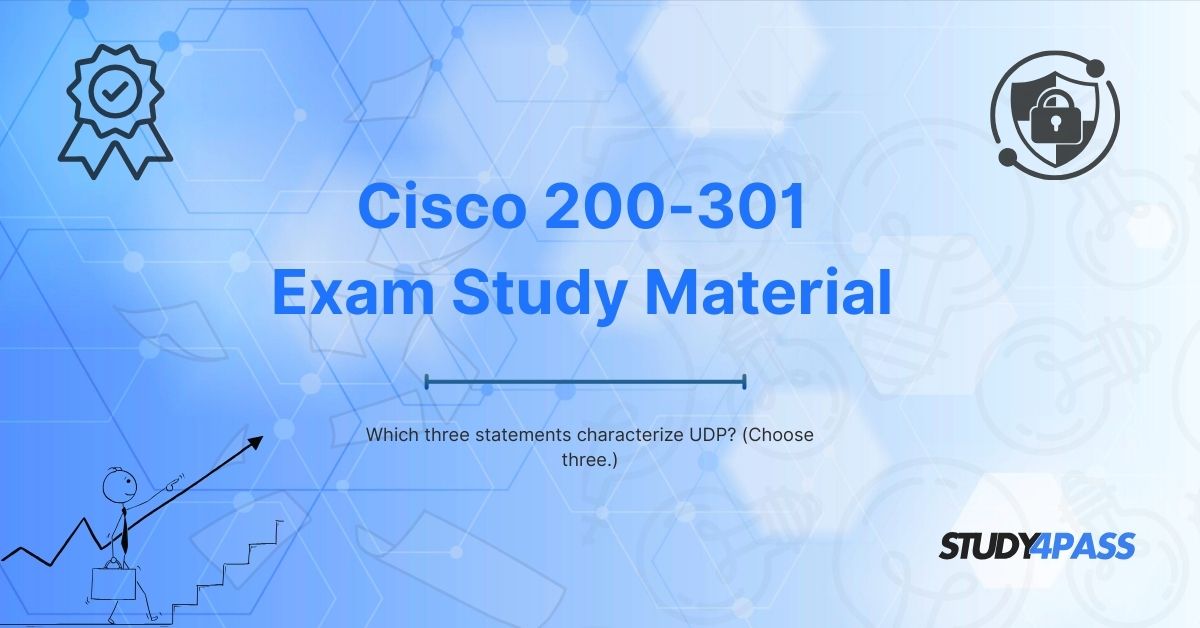Introduction
The Cisco Certified Network Associate (CCNA) 200-301 exam tests candidates on various networking concepts, including transport layer protocols like UDP (User Datagram Protocol). Understanding UDP is crucial because it plays a significant role in network communications, particularly for applications requiring speed over reliability.
In this article, we will explore three key characteristics of UDP that are often tested in the CCNA 200-301 exam. Additionally, we will discuss why Study4Pass is an excellent resource for exam preparation, offering high-quality study materials, practice tests, and expert guidance.
UDP is Connectionless
One of the primary characteristics of UDP is that it is a connectionless protocol. Unlike TCP (Transmission Control Protocol), which establishes a connection using a three-way handshake (SYN, SYN-ACK, ACK), UDP does not perform any handshake before transmitting data.
Why is UDP Connectionless?
- No session establishment: UDP sends data without verifying if the receiver is ready.
- Lower overhead: Since there is no connection setup, UDP reduces latency, making it ideal for real-time applications.
- Example Use Cases:
- DNS queries (Domain Name System)
- VoIP (Voice over IP)
- Online gaming
Exam Relevance
The CCNA 200-301 exam often tests the differences between TCP and UDP, emphasizing UDP's connectionless nature. Study4Pass provides detailed comparisons and practice questions to reinforce this concept.
UDP Provides No Guaranteed Delivery
Another critical characteristic of UDP is that it does not guarantee data delivery. Unlike TCP, which uses acknowledgments (ACKs) and retransmissions to ensure data reaches its destination, UDP simply sends packets without tracking whether they arrive successfully.
Why Does UDP Lack Delivery Guarantees?
- No retransmissions: If a packet is lost, UDP does not attempt to resend it.
- No sequencing: Packets may arrive out of order, and UDP does not reassemble them.
- Example Use Cases:
- Live video streaming (e.g., YouTube Live, Twitch)
- TFTP (Trivial File Transfer Protocol)
Exam Relevance
CCNA candidates must understand that UDP sacrifices reliability for speed. Study4Pass offers real-world scenario-based questions to help learners grasp these trade-offs effectively.
UDP is Faster and More Efficient Than TCP
Due to its minimal protocol overhead, UDP is significantly faster than TCP. Since it omits error-checking, flow control, and retransmissions, UDP is ideal for applications where speed is more critical than data integrity.
Why is UDP Faster?
- No congestion control: UDP does not slow down transmission based on network conditions.
- Smaller headers: UDP headers are only 8 bytes, compared to TCP’s 20-byte headers.
- Example Use Cases:
- DHCP (Dynamic Host Configuration Protocol)
- SNMP (Simple Network Management Protocol)
Exam Relevance
The CCNA 200-301 exam frequently includes questions comparing UDP vs. TCP performance. Study4Pass provides interactive labs and simulations to help students visualize these differences.
Why Choose Study4Pass for CCNA 200-301 Preparation?
Preparing for the CCNA 200-301 exam requires reliable study materials and practice tests. Study4Pass stands out as a top-tier platform for several reasons:
1. Comprehensive Study Materials
- Detailed explanations of networking concepts, including UDP vs. TCP.
- Up-to-date content aligned with the latest exam objectives.
2. High-Quality Practice Tests
- Real exam-like questions to test knowledge retention.
- Performance analytics to identify weak areas.
3. Expert Guidance
- 24/7 support from networking professionals.
- Interactive forums for doubt resolution.
4. Affordable Pricing
- Cost-effective packages compared to other platforms.
- Free trial available for new users.
By leveraging Study4Pass, CCNA aspirants can gain a deep understanding of UDP, TCP, and other critical networking topics, ensuring exam success.
Conclusion
Understanding UDP’s characteristics connectionless communication, no guaranteed delivery, and speed efficiency is essential for the CCNA 200-301 exam. These concepts differentiate UDP from TCP and explain why it is preferred for real-time applications.
For the best exam preparation, Study4Pass provides structured learning resources, expert support, and realistic practice tests, making it the ideal choice for aspiring network professionals.
Final Summary of UDP Characteristics:
- Connectionless – No handshake required.
- No guaranteed delivery – No retransmissions or acknowledgments.
- Faster and more efficient – Lower overhead than TCP.
Prepare effectively with Study4Pass and ace your CCNA 200-301 exam with confidence!
Special Discount: Offer Valid For Limited Time “200-301 Study Material”
Actual Exam Questions For Cisco's 200-301 Certification.
Sample Questions For Cisco 200-301 Exam Prep
1. Which of the following is a characteristic of UDP?
a) Guaranteed delivery
b) Connection-oriented
c) Low overhead
d) Error recovery
2. UDP is preferred for real-time applications because it:
a) Provides flow control
b) Ensures reliable data transfer
c) Has minimal delay due to no handshaking
d) Retransmits lost packets
3. Which statement about UDP is true?
a) It establishes a connection before sending data.
b) It includes sequencing and acknowledgments.
c) It is faster than TCP due to lack of reliability features.
d) It is used for applications requiring ordered data delivery.
4. What makes UDP suitable for VoIP and live streaming?
a) Packet retransmission
b) Low latency and reduced overhead
c) Congestion control mechanisms
d) Guaranteed delivery of packets
5. Which of the following is NOT a feature of UDP?
a) Connectionless communication
b) Checksum for error detection (optional)
c) Flow control to manage data rate
d) No acknowledgment of received packets


